Village Street
-
This is my mother Megan Lowe with members of the Lowe Family could this be in front of 2 Village Street Everton 1921

-
In 1851 George Lowe was living at 8C Prince Edwin Lane the family moved to 8 Browside then to 2 Village Street Everton as shown in the business directory. I have pictures of all three areas but cannot identify where my family were. Any help to identify 8C Prince Edwin Lane, 8 Browside and 2 Village Street would be greatly appreciated.
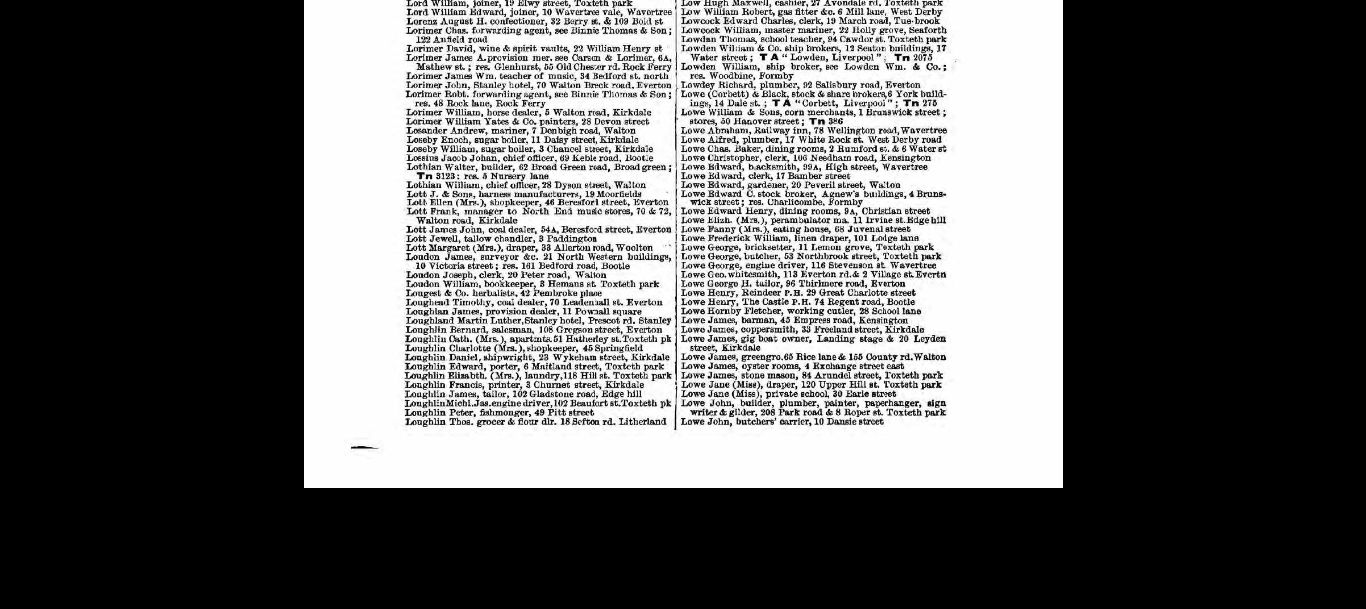
-
An unusual and early Everton Toffee advert for the shop at 21 Village Street, now describing the Toffee Lady as Mrs Noblett. It was Molly Bushell, of course, who first launched the famous toffee from her cottage on Village Street before the business was moved just below Browside. More images further down this reel.

-
Fantastic picture of the Gospel Hall Chinese Mission at 22 Village Street in 1911. Intriguingly, no Chinese nationals or Liverpool Chinese appear to be in the image. My family, from Everton, married into a Chinese family at this time which was unusual and we are very proud of this link. The Rogers lived in Copeland Street, within shouting distance of Village Street. My father's aunt Maria Rogers married seaman Chan Muk Chin and he ultimately had a powerful position engaging Chinese seamen on the Birkenhead Docks. As far as I know, my family had no links with that Everton Chinese Mission, but I am still in touch with the Chins.
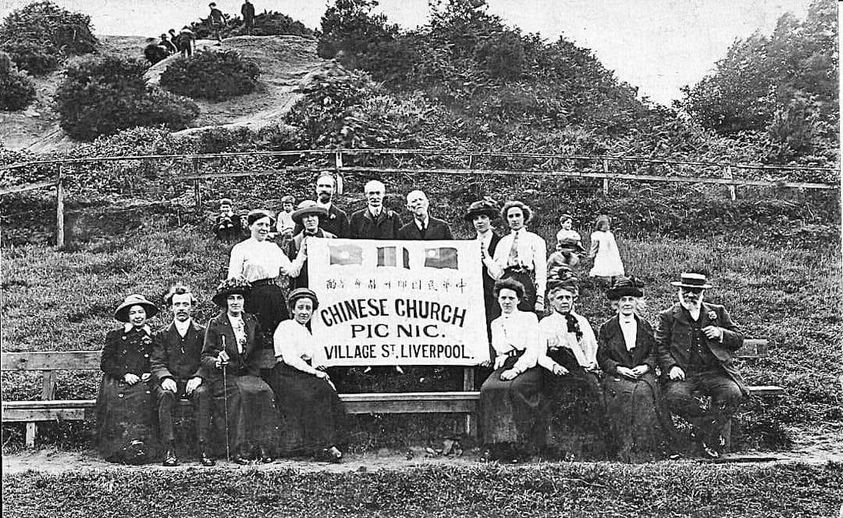
-
The cottages and properties that made it such an historical place for hundreds of years have all gone, Everton's famous Village Street being something of a green oasis these days. Established trees are the new residents on the southern boundary of the modern Everton Park, this image looking down towards Browside and Netherfield Road South. On the left once stood the famous Queen's Head pub where, in 1879, St Domingo's fledgling football team had a meeting and decided to change their name to Everton FC. This rather desolate looking spot was therefore the birthplace of big time football on Merseyside and the rest, as they say, is history. It is marked only by a heritage board installed by the Friends of Everton Park although a successful archaeological dig took place on the site in 2015.

-
Denis Hargreaves of the Netherfield Road & Surrounding Area Facebook platform uploaded this fascinating 1890s picture of the Noblett's Everton Toffee Shop on Village Street, close to the site of the original cottage from where a young Molly Bushell started making her toffee in the mid 1700s. Molly would never grasp the ultimate football link. She died in 1818, 61 years before the fledgling St Domingo's football team met at the Queens Head Hotel on Village Street (1879) and decided to change their name to Everton FC. The rest, of course, is football history. By then Everton Toffee had earned national renown, leading to the Blues being dubbed the Toffees. The advert below shows how quickly it gained royal patronage.

-
See caption above.

-
From the Heyworth Street Facebook platform, two images are cleverly linked to recreate the top of Village Street.

-
Here is the old weighing machine that was on the corner of Everton Road and Village Street, pictured in 1904. Lorries would drive on to check their loads. This image gives a tantalising view of the top south side of Village Street with its large properties. A few doors down Village Street was the Queen’s Head Hotel where, in 1879, St Domingo church football team took a momentous decision to change its playing name to Everton FC, the start of big time football on Merseyside. I love the adverts on the wall, specifically one for Hartley’s marmalade which is particularly relevant. William Hartley, the man who founded the Hartley’s Jam empire with a major factory in Long Lane, Aintree, was one of the individuals who willingly put up a significant part of the money that, in 1892, enabled Everton FC to build its new Goodison Park stadium. Perfectly fitting to have a Hartleys advert on a gable end wall around the corner from a major EFC historic site.

-
A fascinating Everton Village map from 1824. You can pick out the fairly new St George's Church (top left) which was just 10 years old at this stage. Lodge Lane would eventually become Northumberland Terrace and Church Street above it would become Heyworth Street. Likewise Netherfield Lane North & South would become Netherfield Road N & S. You can see the fields along Netherfield Lane, the boundaries of which would soon morph into the streets that ultimately formed the concrete jungle of Victorian Everton. Often these terraced streets would take the name of individuals who owned the old fields. It's interesting that streets like Roscommon & Prince Edwin were already in place at this time below Netherfield Lane South. Of course, it's fascinating to look at Everton Village with the triangle of land below that still holds the Everton Lock Up Tower. Rupert Lane to the left of the Village pays reference to Prince Rupert of the Rhine who, in 1644, used Everton as his base before attacking and taking the town of Liverpool below in the English Civil War. Rupert Lane later stood with its big Victorian Houses until the 1960s demolition derby and is now a path within the modern Everton Park. You can see various mansions dotted here and there. Everton, with its pubs and Halliday's Coffee House, was a major a tourist draw during those 1800s summers, boasting spectacular views across the Mersey. This map highlights those early days when this area was very much part of the countryside, soon to be much changed.

-
Merseyside is famous for its football history, but this is where it all began on what is now the spectacular modern Everton Park. When I saw this Village Street image, reproduced on the excellent Netherfield Road & District Faceboook platform, it demanded I offer some more details. The same picture, in a smaller format, appears further down this picture reel along with an artist's impression of the site from the late 1800s when it played a remarkable part in the birth of big time football on Merseyside, The fact that this is heartland Everton will give you a clue. So let's start with this image of Everton Labour Club with electioneering posters up for local Labour candidate of the day Syd Jacob. Many people will remember the building which was finally demolished in the 1960s. However, it belies the real significance of the property which had previously been a well known local dairy that had emerged from a cow keeper's house, supplying fresh milk to the Everton locals for many decades. Before that, this was the Queen's Head pub where the committee of the fledgling St Domingo's Methodist chapel football team, playing at that time in the fairly new Stanley Park, had begun to hold their meetings. At one such gathering, in November 1879, their main agenda item was a potential new name with the team now attracting significant interest in the new game of Association football. After a few hours (and almost certainly a few pints) that night they emerged to proudly declare that St Domingo's would now play under the wider district name of Everton FC. The rest, as they say, is football history. Not only was the Queens Head EFCs first headquarters, it provided the club's first secretary in the shape of John W. Clarke,son of Queens Head landlord John Clarke. On July 18, 2015, I arranged for an archaeological dig to take place at this site to unearth the foundations of the Queens Head Hotel. I got the support of Dr Mark Adams, lead archaeologist from the Museum of Liverpool, along with his colleague Dr Liz Stewart, In the presence of the Everton FC Heritage Society and members of the Friends of Everton Park, this successful dig was a complete success. Victorian bricks and distinctive pub wall tiles began to emerge as did many oyster shells, oysters being a cheap and very popular local pub delicacy in those days. Most significantly, we discovered a Victorian stoneware inkwell. I mused with Dr Adams if this might have been used to sign off the name change from St Domingo's to Everton FC. We could never prove it, of course, but it demonstrated that even archaeologists who deal only in facts can sometimes share a romantic vision. This was all part a research project I undertook for my 2016 book 'Born Not Manufactured'. Along with thousands of other kids, I played my own early football on the steep streets of Everton. I would later progress to become the Liverpool Echo's Everton & Liverpool football correspondent and later sports editor, covering local and national football events, but nothing would give me as much pride and pleasure as discovering where it all began for our massive football city, the site of the Queens Head Hotel . . . yes, the birthplace of big time football on Merseyside within 30 yards of the tower on Everton FC's badge.

-
An artist’s view of the top of old Everton Village. Another slightly different view of the ancient sundial is further down the reel.

-
Village Street 1856

-
Village Street is devoid of its old cottages, houses and pubs these days, being the southern boundary of the modern Everton Park, but I love pictures like this. The garage is interesting, of course, but it is the old house to the right that fascinates me. I did wonder if this was actually Rupert Lane, but the caption definitely said Village Street.
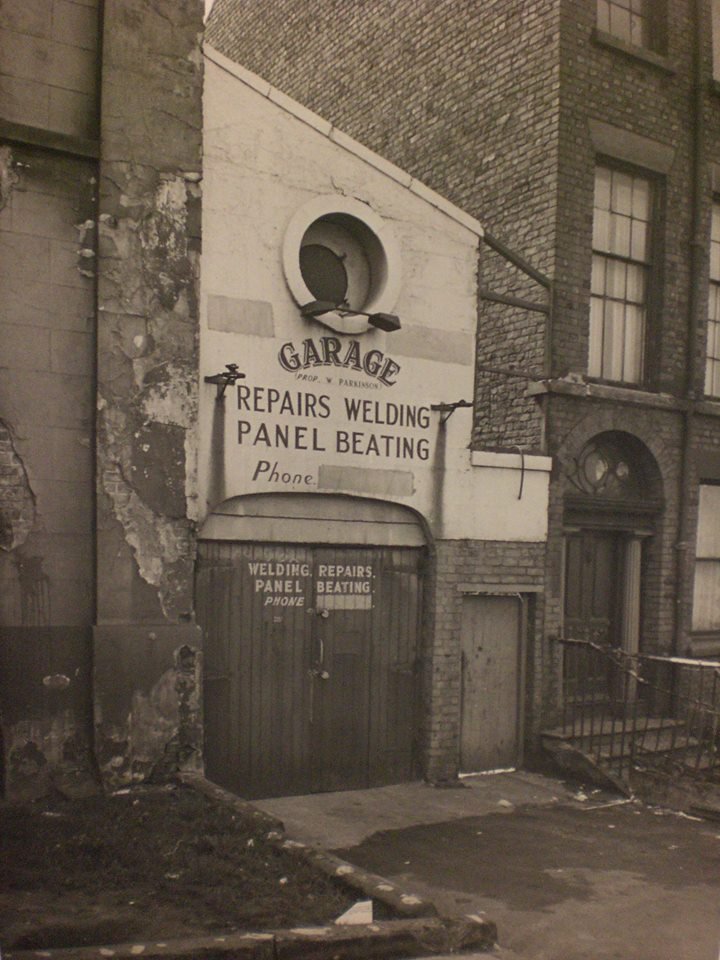
-
Village Street, showing the People's Church and Town Appeals Office in 1961. From Gerard Fagan's inacityliving site.

-
Brilliant photographs that I will view on a regular basis. Thank you so much for posting
-
Those ancient days in the early 1800s when you could drive a herd of sheep or cattle up the middle of Everton Village which, at that time, was a picturesque idyll much loved by those in the town of Liverpool below who would come up to Everton to drink in one of its famous pubs, have a picnic in a nearby field, or just stroll across the ridge with its magnificent views of the Mersey and beyond.

-
Two fascinating pictures, one a late 1950s photograph looking down Village Street before demolition and the other a painting of the village in the late 1800s looking up the hill at the same site. The property with the pointed roof in the photo can also identified if you look carefully at the painting. This section of Village Street is important, being the birthplace of big time football on Merseyside. This is where the Queen’s Head Hotel stood, the pub where, in 1879, St Domingo’s football team took the momentous decision to change their name to Everton FC. The Queen’s Head Hotel would later become a cow keeper’s house which supplied milk to local people, later becoming a more traditional dairy. By the late 1950s it had become the Everton Labour Club prior to demolition in the 1960s.
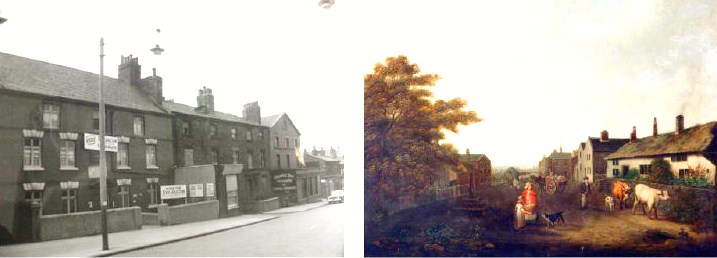
-
This is a remarkable colour painted image of Everton ridge with its grand mansions circa 1820, looking across the fields towards what was then the fairly new and prominent St George's 'Iron Church'. Immediately to the left of the church is the mansion of James Atherton, the inspiration behind much of the villa development at this time. His grand property steep garden would have run down to Netherfield Road which featured mansion properties on both sides. A curving path and a straight lane lead down to another boundary line which would ultimately become Great Homer Street with cattle grazing in an adjacent field. At the front of this image two more cows are at rest, while a lady walks with a container on her head, presumably containing water from a nearby well. The actual Everton Village street is out of the picture to the right.

-
Looking down Village Street prior to the demolition.
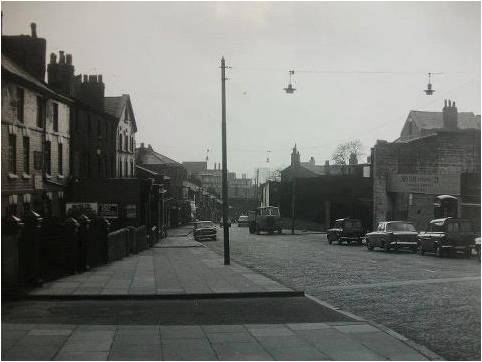
-
The lower end of Village Street on the north side showing the Brunswick printers. In the original ancient village, cottages stood along here. This is now the Village Street southern boundary of the modern Everton Park.

-
The well known People's Church that stood on the north side of Village Street before demolition in the 1960s.

-
Everton Village by renowned artist Herdman, as it looked in the early 1800s with its Village Cross. Molly Bushell's cottage is on the left. She was the proprietor of the first Everton Toffee Shop on nearby Browside where she used a recipe originally given to her by a local doctor. Everton FC are called the Toffees.

-
An intriguing overhead shot of Village Street with its buildings still intact before demolition.
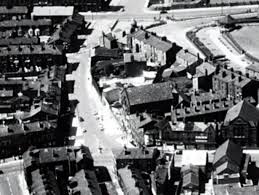
-
Village Street was once at the heart of Everton. The street remains, but without its ancient pubs and cottages, being part of the modern Everton Park.


Thank you for your contribution!
Please check back in 24 hours to see if your photo has been approved.
Return